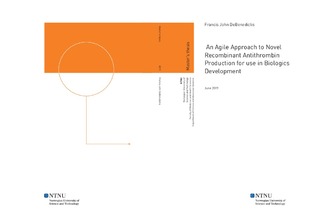| dc.description.abstract | Background:
Sepsis is a deadly medical condition caused by a runaway inflammatory response to systemic infection in which the release of extracellular cytotoxic histones has been linked to disease progression. Heparin has been found to bind to and inhibit histone-mediated sepsis progression and cytotoxicity, but medical heparin is an anticoagulant and increases the risk of haemorrhaging in haemostatic factor depleted sepsis patients. Antithrombin III (AT) can be used to separate unfractionated heparin into an anticoagulant fraction and a non-anticoagulant fraction. Non-anticoagulant heparin could be greatly beneficial for neutralizing extracellular histones in sepsis patients without increasing haemorrhagic risk, thereby increasing the survival rate of septic patients without the potential for unintended lethal side effects.
Scope:
The scope of this project is to develop a production method for recombinant human AT in a prokaryotic expression vector. The primary goal is to assess the viability of prokaryotic recombinant AT production for medical use in purifying non-anticoagulant heparin. The secondary goals include the assessment of a novel cell-free production method in contrast to the prokaryotic expression and establishing the identity of the purified protein through biochemical means such as mass spectrometry and plasmon resonance analysis. These secondary goals were established to be conducted once the primary goal had been satisfied.
Methods:
A pET30a(+) plasmid carrying a human antithrombin III insert was amplified in DH5α cells and transformed into a BL21(DE3) pLysS expression host. Recombinant protein production was induced with IPTG, harvested, purified with either Ni-NTA HisTrap column and/or Heparin-Sepharose column. Purity was assessed with Coomassie Brilliant Blue staining and Western Blot, and functional activity was determined by anti-IIa activity assay. Results were analysed and the process was reviewed for sources of error or improvement. Recommended changes were introduced to the protocol and tested in a subsequent batch production cycle. Each batch cycle further refined the process and advanced the protocol towards the completion of the primary goal: production and purification of recombinant AT. | |
